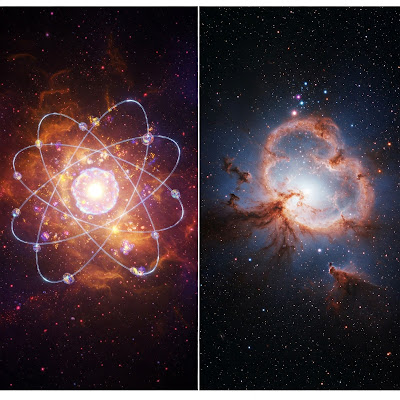Into the second half of Lent, downhill towards Easter. Going nicely. Today, I want to turn my attention to what we consider to be our 'reality'. Solid things, people, places, arranged in space and time – we feel we know exactly what reality is. We can sense it all around! But do we truly understand?
We can all agree that everything's made out of molecules, which in turn are made out of atoms. Yet none of us have ever seen an atom – even nuclear physicists will only have seen something that's a representation of an atom. Yet within those atoms exist smaller particles; electrons forming a probability cloud around a nucleus, which scientific consensus assures us is made of protons and neutrons, each made of up quarks and down quarks, though how that works (gauge bosons, gluons, leptons, whatever) is way beyond the understanding of all but the most dedicated specialist. So we end up take the Standard Model on trust, rather like in early times, mediaeval people would take the existence of Jesus Christ as the only begotten son of God on trust.
Below: how Google Gemini's Imagen 3.0 pictures the sub-atomic (not very accurately, but try illustrating a cloud of probability) and the pangalactic.
We scarcely give any thought to the fact that the chairs we sit on consist of atoms that are essentially empty space. And yet they are. A hydrogen atom is about 99.9999999999996% empty space. If the nucleus were the size of a pea, the atom would be about the size of the dome of St Paul's Cathedral. Looking out over a landscape we're seeing fields and forests, fences, clouds and sky – what we're really gazing at is unimaginable numbers of atoms.
And the planet on which we live is whizzing around our local star, one of between 100 billion and 400 billion stars in our local galaxy. Which is just one of 200 billion to 2,000 billion (or two trillion) galaxies in the observable universe.
Just as we are unable to grasp the subatomic nature of reality, we cannot grasp the galactic scale either. Yes, we can recite the numbers, how very tiny and how very huge they are, but our imaginations struggle.
You may try to deny the reality of reality, but to do so would be to question the physicalist model agreed upon by science. No rational thinker in the Middle Ages would question the existence of God either.
As human beings, we have evolved in the meso-scale; that is where we are; what lies above and below is of no evolutionary consequence to us. Finding food, finding a mate, avoiding predators. If you can do that, you are biologically fit.
Cognitive psychologist Donald Hoffman argues that in the same way as our laptop screens show us, via a graphic user interface, icons, words and images so that we can operate our devices, which are essentially voltages running through silicon, we relate to the world around us via a 3D graphic user interface in our mind. This interface, says Prof. Hoffman, evolved to perceive reality in a way that works best in evolution. Escaping tigers is more useful than seeing inside of an atom or scanning distant galaxies. Natural selection selected the optimal model for us to interface with reality.
Yet despite this, we cannot deny the existence of the subatomic or the innards of a black hole.
I would posit that much the same can be said about the reality of consciousness; all we know of it is what we experience at our own subjective level – qualia; units of the awareness of being. You know what it feels like to be you; you can imagine what it may be like to be me, but we'd both struggle to imagine consciousness at the subatomic or the cosmic level.
We can but intuit; reaching up to try to understand the nature of the Divine Consciousness is akin to gazing at the heavens without a telescope.
Lent 2024: Day 24
The Ego Alone
Lent 2023, Day 24
We are all Sentinelese?
Lent 2022: Day 24
Memory, identity and reincarnation
Lent 2021: Day 24
Reconciling science and spirituality
Lent 2020: Day 24
Refutation (II)







No comments:
Post a Comment